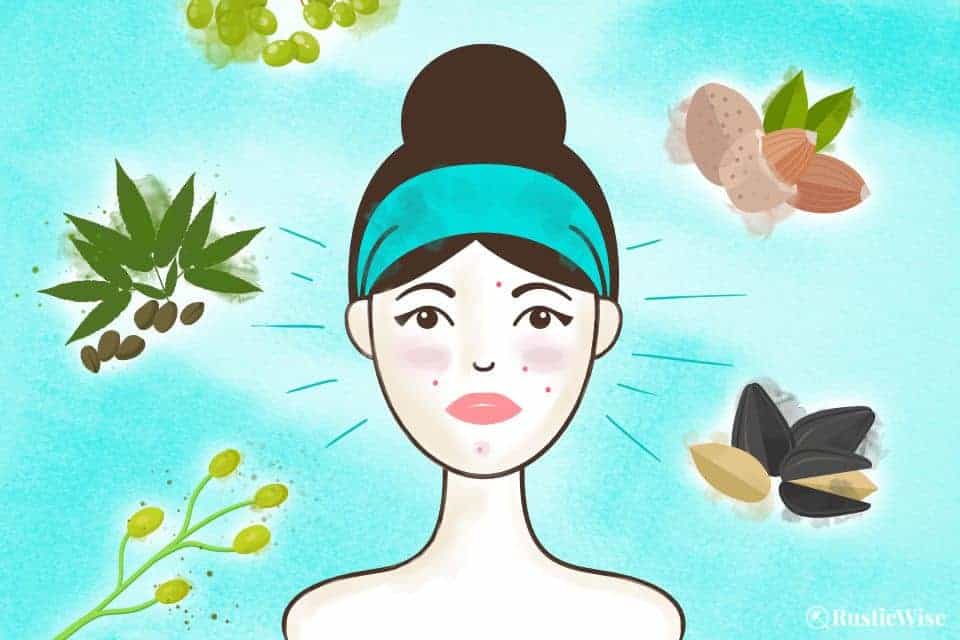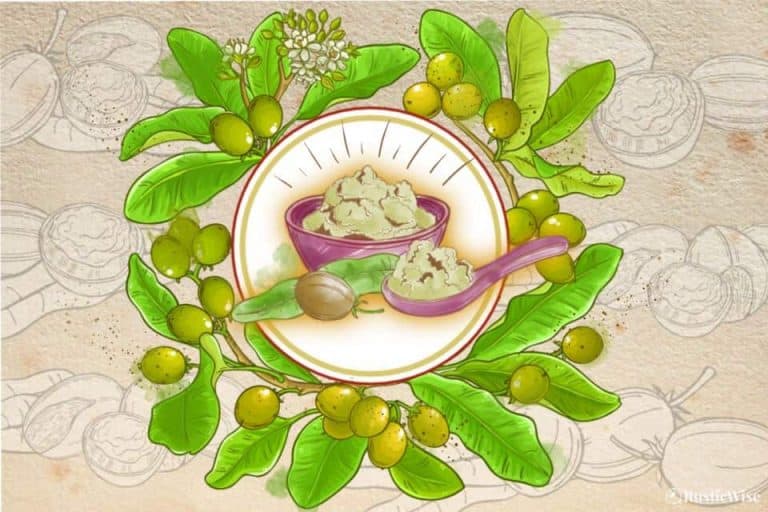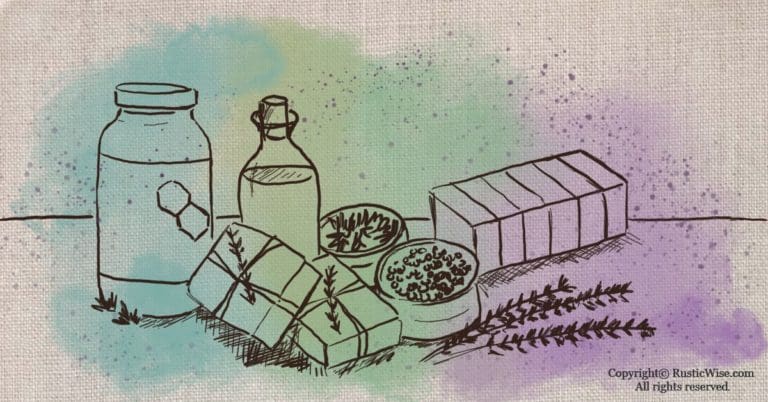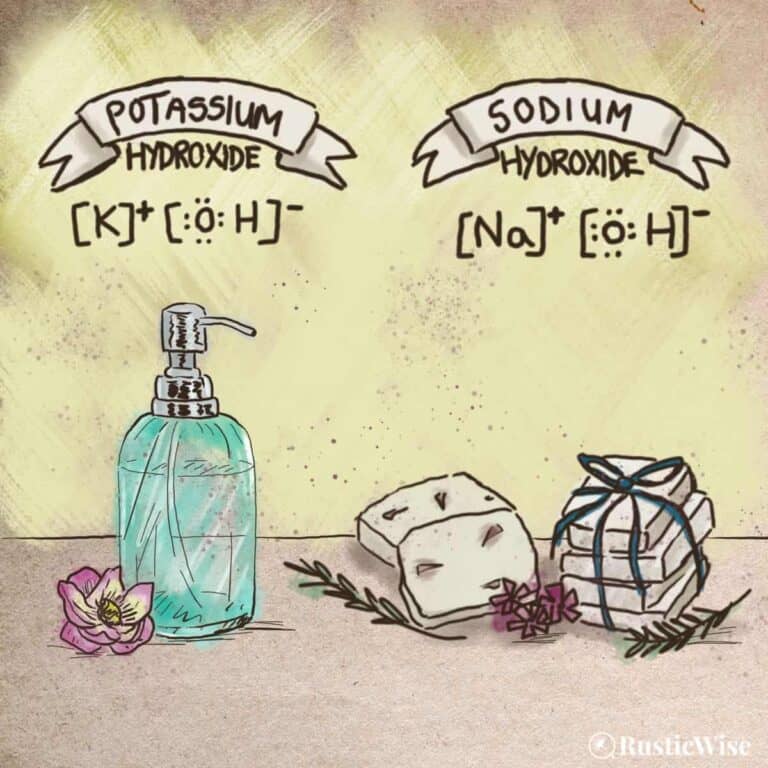Natural Soap for Acne: Mild Ingredients with Antibacterial Properties
If you struggle with acne, you’re not alone. Over 85 percent of teenagers experience acne to some degree, and many adults have persisting acne throughout the adult years.¹
If you’ve tried many harsh over-the-counter acne medications or commercial face cleansers and are looking for something gentler, natural soap for acne may be just what you need. Many store-bought detergents contain sodium lauryl sulfate (SLS) which can irritate sensitive skin.
A good natural soap bar for acne contains skin-nourishing plant-based oils which gently cleanse without stripping skin of natural, healthy oils.
We’ll check out the ingredients to look for in a good soap for acne, and types of non-comedogenic vegetable oils safe for skin. We’ll also cover natural antibacterial ingredients vs. chemical antibacterial agents. You can get healthy glowing skin—without the use of harsh chemicals!
A closer look at acne and its common causes
What exactly is acne? The University of California-Berkeley says, “Acne is a common skin condition that occurs when oil and dead skin cells clog the skin’s pores.”¹
Acne affects everyone differently. While many people experience facial acne, it can also occur on areas of the body including the neck, back, chest, and shoulders. Many teenagers experience acne due to fluctuating hormone levels.
Women, too, can experience hormonal acne throughout adulthood due to menstrual cycles. But men are more prone to suffer from severe and longer lasting acne.¹
And just as acne affects everyone differently, acne-prone skin types are different too:
- You may have dry skin, or patches of flaky skin;
- You may have very oily skin;
- You may have combination skin (both oily in areas, and dry in others); or,
- You may have sensitive skin.
Those with acne have an impaired skin barrier. Loss of moisture comes easily, which leaves skin feeling irritated, dry, and unable to protect against bacteria and other environmental elements.
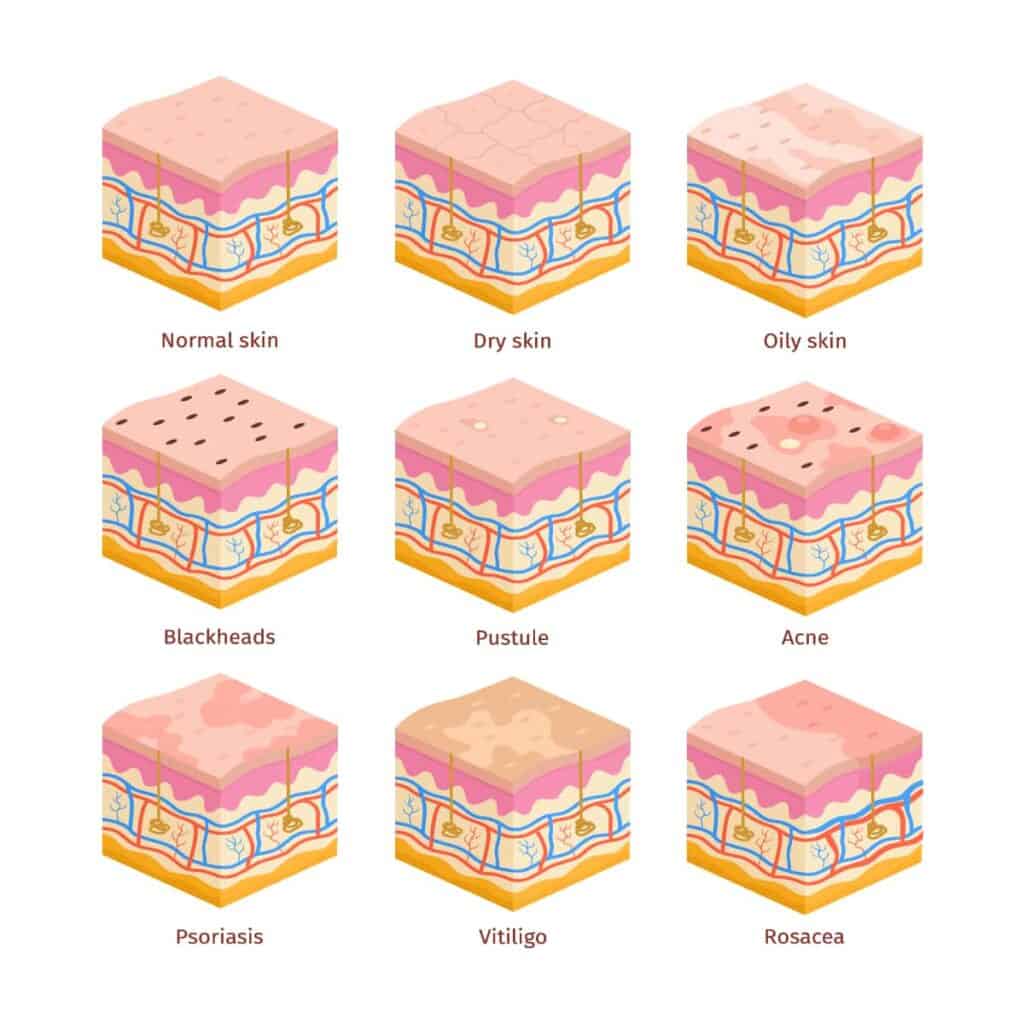
Credit: Vector State
Common causes of acne
There are many causes of acne. Let’s take a closer look.
- Hormones: Hormonal changes are one of the most common causes of acne. As the body goes through puberty, changing hormones cause the sebaceous glands to make more oil (sebum). Normally, this sebum passes through hair shafts to lubricate the skin. But, sometimes dead skin cells block sebum from releasing through to skin. This clogged pore forms a comedone, or blemish.
- Stress: While stress doesn’t directly cause acne, it can make it worse if you already have acne. During times of stress (studying for finals, a challenging job interview), the body’s cells that produce sebum act out. If you notice acne flareups during difficult times, you might not be imagining it.
- Pore-clogging cosmetics or skincare products: When buying makeup, lotions, cleansers, and soaps, it’s important to avoid comedogenic ingredients which may clog pores. Look for labels with the term “non-comedogenic.”
A common acne myth debunked
It’s a common misconception that chocolate or junk foods may cause acne. According to Harvard Health, many studies have looked for causal links between diet and acne.²
The results of the studies show either weak or non-conclusive links.
Some studies found links between dairy and acne. Others found that low-glycemic diets (those rich in whole fruits and vegetables, and unprocessed foods) were linked to improved acne. Still, results were sketchy at best.
The takeaway: If you find that certain types of foods seem to exacerbate your acne, it’s a good idea to speak to your doctor. And whether or not you have acne, the best and most healthy diets are those rich in fresh fruits, veggies, and unrefined foods. Eating a well-balanced diet can promote healthy skin from the inside out.
Why we really need facial cleansers
It turns out the world around us is a harsh place.
More specifically, environmental pollutants and many skincare or cosmetic products are water insoluble. This means simple water is not enough to cleanse the skin, which is why we turn to facial cleansers.
There are many facial cleansers on the market today to choose from. At their core, they all serve the same purpose—to remove impurities such as oil, excess sebum, dirt, makeup, and microorganisms from the skin.
While the ingredient lists may differ from product to product, the key component of cleansers are surfactants, such as those found in bar soap or body soap. Surfactants work by reducing surface tension on the skin and allowing impurities to bind to the soap molecules. Dirt and oil can be more easily washed away.
The best soap for acne would ideally cleanse the skin without irritating the surface—all while keeping it moisturized. In other words, it would be non-comedogenic, non-irritating, and non-allergenic.³
Note: Many people experience dryness or sensitivity after cleansing with bar soap. This is because the skin is naturally more acidic, while natural soap bars are alkaline, most with a pH between 9 or 10. The tradeoff is that many “pH balanced” products may contain harsher cleansers that may strip skin of natural healthy oils. Below, we’ll cover what natural ingredients to use or look for in natural soap for acne.
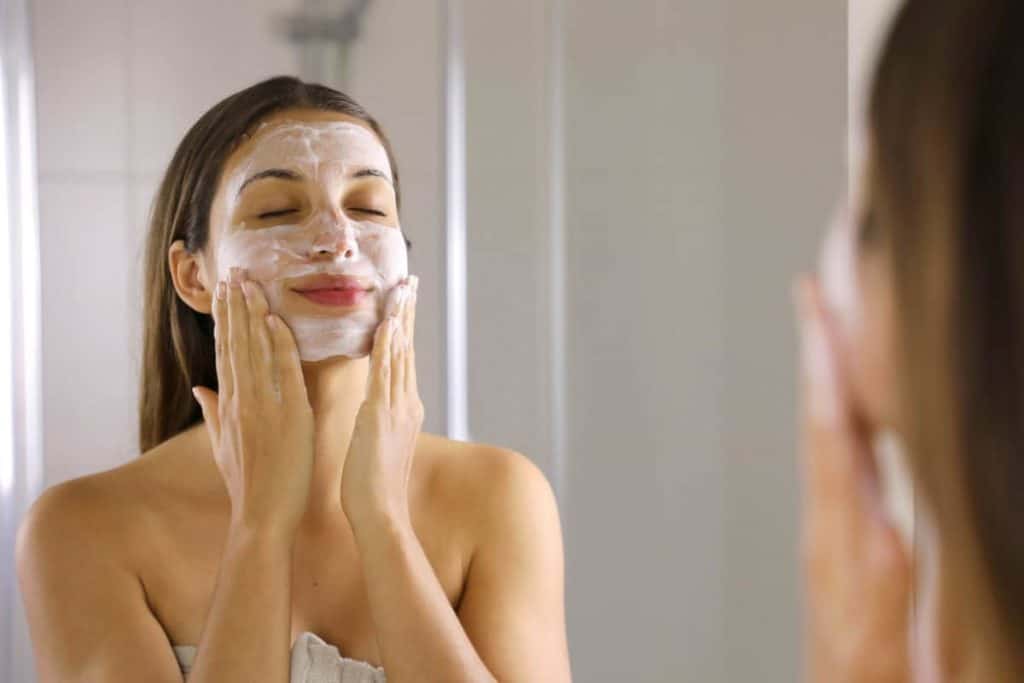
Are natural soap bars antibacterial?
According to the Cambridge Dictionary, the term antibacterial applies to something that is “intended to kill or reduce the harmful effects of bacteria especially when used on the skin.”
It’s important to note that natural soap bars (or regular liquid soap for that matter) remove bacteria, but do NOT kill bacteria from skin. This means that we do not consider regular soaps truly antibacterial.
However, plain soap is still effective at removing bacteria from skin.
With proper handwashing technique, studies show plain soap removes around 82 percent of bacteria from hands.⁴
How does soap work to cleanse skin?
Here’s how soap works.
Soap molecules have special properties: one end is hydrophobic (repels water), while the other end is hydrophilic (loves water). In a nutshell, one end cozies up with oil (and dirt, other impurities, etc.), and the other end plays nice with water.
When you combine soap and water, the soap molecules form small clusters known as micelles. Each micelle cluster contains hydrophobic heads grouped in the center. These hydrophobic heads grab onto oil and dirt. Meanwhile, the hydrophilic tails face outwards (which mix with water).⁵
This allows each cluster to grab and trap oil and dirt in the center. The water-loving tails facing outward allow it to wash clean away.
Natural antibacterial ingredients vs. antibacterial chemicals
It’s important to note that antibacterial properties can come from natural ingredients such as essential oils and certain plants. Or, it can come from antibacterial chemicals.
Antibacterial chemicals
We all want to stay safe and keep bad bacteria at bay. But it turns out that we don’t really need antibacterial chemicals to do this.
Two common chemicals once found in household antibacterial products are triclosan and triclocarban.
Since 2016, the U.S. Food & Drug Administration (FDA) has banned these two substances as they are linked to heightened asthma, hormone disruption, and poor gut health.⁶ (However, they are still used in some hospital settings.)
Besides, the FDA did not find that products marketed as antibacterial performed any better than plain soap and water.
So, when washing hands and face, be wary of products labelled as “antibacterial.”
(The whole idea of needing to kill bacteria in order to meet the definition of “clean” is over-rated in my opinion.)
Natural antibacterial ingredients
If you’re looking for a more gentle way to keep your skin healthy, you can find a variety of natural (or organic ingredients) in natural bar soaps. Some vegetable oils, essential oils, and other soap additives contain natural antibacterial properties.
Essential oils with antibacterial properties
Essential oils are extracted from natural botanicals and their various parts, including the flowers, leaves, steams, or roots. (Compare this with fragrance oils which are lab-derived and contain no therapeutic benefits.)
EOs contain active and volatile compounds that have various therapeutic benefits. Always read up on EO safety before using.
When buying or making your own bar of soap for acne, here are a few essential oils that contain antibacterial properties:⁷
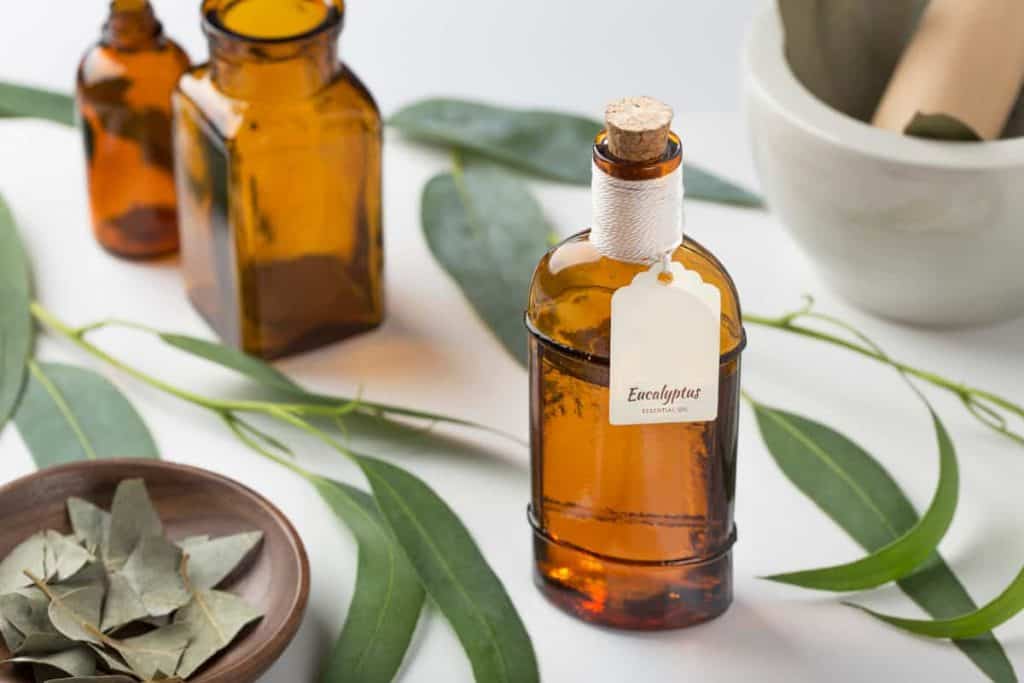
Credit: Vector State
- Eucalyptus essential oil: A popular uplifting scent that helps reduce oiliness.
- Geranium essential oil: Astringent and anti-inflammatory properties with floral and herbaceous notes.
- Juniper essential oil: A crisp scent that soothes irritated skin and has antiseptic properties.
- Lavender essential oil: While most people associate lavender for its calming and soothing properties, it’s also a good EO for treating acne and dermatitis.
- Lemongrass and/or lemon essential oil: These citrus EOs have antiseptic properties and are good for oily skin.
- Orange essential oil: Sweet orange EO is an uplifting and warming scent with powerful antibacterial properties suitable for acne-prone skin.
- Palmarosa essential oil: Distilled from grasses, palmarosa helps with acne and moisturizes dry skin.
- Patchouli essential oil: A strong and distinct scent that contains skin regenerating properties.
- Peppermint essential oil: A stimulating scent. Use in small doses as it may cause skin to feel tingly.
- Tea tree essential oil: Tea tree oil is a perennial favorite in skincare products for its antiseptic properties.
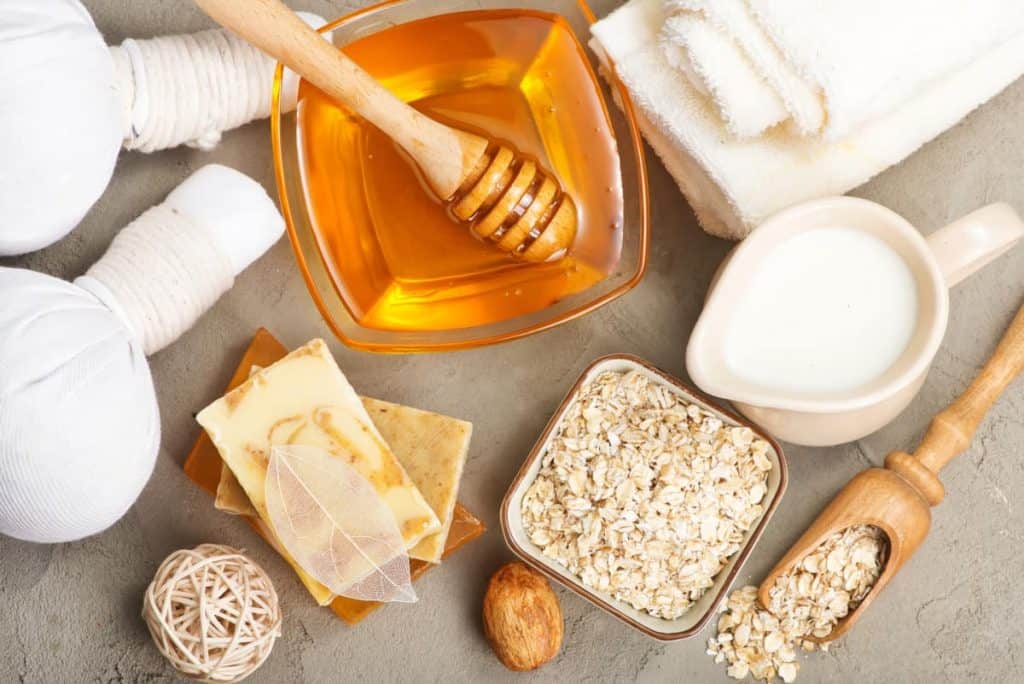
Credit: Yay Images
Other natural additives good for acne herbal soap include:
- Clays: Certain clays are gentle and milder—perfect for those with sensitive skin. Kaolin clays are suitable for most skin types and especially if you have dry skin (as it has milder oil absorbing properties). Bentonite clay is good for very oily skin types. And French green clays are perfect for treating acne with its purifying properties.
- Raw honey: Raw honey has long been used to heal and cleanse skin, which makes it a perfect addition to natural skincare products.
- Goat’s milk: One of the most nourishing ingredients to add to soap for blemishes is goat’s milk. Milk soap contains lactic acid, which is a natural and mild cleanser that also moisturizes skin. It also sloughs off dead skin cells leaving skin feeling rejuvenated.
- Colloidal oatmeal: For a soothing and natural exfoliator, colloidal oatmeal is safe for most skin types including those with acne, eczema, and psoriasis.
Does SLS dry out the skin?
Look at the product details on most commercial soaps and shampoos. One of the first ingredients is typically sodium lauryl sulfate (SLS).
SLS is a harsh synthetic surfactant used in many products to lessen surface tension and create lather. It’s a powerful cleaning agent that can often strip skin of natural oils.
Our skin’s natural protective barrier (sometimes called the acid mantle), keeps bad bacteria out while locking in moisture. Sometimes when we use products that contain synthetic ingredients like SLS, it can disrupt the natural and healthy balance of the skin.
You end up with dry, or irritated skin. Red, itchy, or sore patches may appear on skin. And SLS happens to be one of the stronger, more irritating surfactants on the market.
Studies show that SLS can both irritate the skin AND penetrate the skin causing lasting damage. A German study examined 1,600 participants who used products with SLS. They found 42 percent of people experienced skin irritation.⁸
Some studies also found that the warmer the water when washing with SLS, the greater the skin irritation.
Tip: For dry skin, sensitive skin, or acne-prone skin, it’s best to avoid products containing SLS. Natural soaps made using cold process or hot process methods do NOT contain SLS.
Why you want to use vegetable oils on your skin
Many facial cleansers or soaps may contain mineral oil. Mineral oil, a petroleum-derived product, is safe to use on acne prone skin, and is non-comedogenic. However, it doesn’t hold a flame to vegetable oils.
All vegetable oils are unique and contain various fatty acids. However, most vegetable oils do the following for skin:
- Penetrate deep within skin layers to moisturize skin from the inside out. In contrast, mineral oil sits on top of skin.
- Contain antioxidants which help protect the skin from free radicals.
- Some vegetable oils also have natural antibacterial and anti-inflammatory properties.
Those who have acne may have red, itchy and inflamed skin. To repair the skin barrier, use vegetable oils topically (or in soap).
All vegetable oils contain a unique fatty acid profile consisting of a variety of saturated and unsaturated fats.
Studies have found vegetable oils containing, “a higher linoleic acid to oleic acid ratio have better barrier repair potential, whereas oils with higher amounts of irritating oleic acid may be detrimental to skin-barrier function.”⁹
And the method of extraction matters too.
To cause the least amount of irritation to dry skin, look for oils that are cold pressed and don’t use chemical solvents.
Vegetable oils with strong cleansing power
Vegetable oils high in lauric acid can leave your skin feeling dry and stripped if you use too much. Go easy on these oils when making a new soap recipe just to be safe. Oils with a lot of lauric acid create a cleansing bar of soap. They make hard soaps with great lather—fun to work with and very effective at stripping excess oils.
Most oils high in lauric acid are saturated oils (those that are solid at room temperature). A few examples include:
- Babassu oil
- Coconut oil
- Palm kernel oil. Note that PKO, derived from the kernels of the palm fruit, contains high lauric acid, while palm oil (derived from the palm fruit) does NOT contain any.
Soap making tip: To keep the cleansing properties of lauric acid in check without over drying skin, keep the amount of lauric acids between 20 and 30 percent in most soap recipes. Balance the properties of lauric acid by using soft oils with moisturizing qualities such as olive oil or sunflower oil.
Gentle vegetable oils for sensitive or acne prone skin
A good bar of handcrafted natural soap for acne needs to strike a balance between cleansing and moisturizing properties. To balance out the hardness and cleansing qualities of some veggie oils such as coconut, use mild and moisturizing oils.
Most often, these oils contain unsaturated fatty acids which produce softer, more moisturizing soaps that are less cleansing.
The following vegetable oils are non-comedogenic (won’t clog pores):
- Argan oil: Derived from argan nuts, this skin-nourishing oil is high in antioxidants. It’s also known for its anti-inflammatory properties and is a popular ingredient in hair care treatments.
- Grapeseed oil: A byproduct of the wine making process, grapeseed oil is coveted for its antimicrobial properties and its skin softening abilities.
- Jojoba oil: Used for its skin smoothing and softening properties, jojoba oil also helps to keep oily skin under control.
- Oat oil: Great for soothing and rehydrating skin.
- Olive oil: A widely used base oil for many soap recipes for its gentle and moisturizing properties. Bonus—it’s also rich in vitamin E and antioxidants. On its own, it makes for a soft bar of soap. You’ll often find it paired with a harder oil such as coconut oil.
- Sunflower seed oil: A light oil that’s easily absorbed by the skin. It’s also rich in vitamins.
- Sweet almond oil: This nutty oil is great for soothing sensitive skin and healing minor lesions.
The takeaway: natural soap for acne
Now that you’re armed with more knowledge about the root causes of acne and which ingredients to avoid, you can go out and search for the best soap for acne for your unique skincare needs.
If you have very sensitive or dry skin, avoid products containing harsh surfactants like sodium lauryl sulfate (SLS) which may exacerbate already dry skin. There are many natural ingredients that are gentler on skin and contain antibacterial properties that may help keep acne in check.
New to making soap? 🧼❓
👉We have a fantastic overview on the whole soapmaking process here: read our Timeless Guide To Soapmaking.
If you would like to see our soapmaking posts organized by topic type, see our Soapmaking Collection.

References
- University of California, Berkeley, Acne Fact Sheet, https://uhs.berkeley.edu/sites/default/files/acne.pdf. Accessed March 2022.
- Campos, Marcelo (15 January 2021). “Acne: What you need to know,” Harvard Health Blog. Accessed March 2022.
- Mukhopadhyay P. (2011). Cleansers and their role in various dermatological disorders. Indian journal of dermatology, 56(1), 2–6. https://doi.org/10.4103/0019-5154.77542
- Rangel, Gabriel (09 January 2017), “Say Goodbye to Antibacterial Soaps: Why the FDA is banning a household item,” Harvard University. Accessed March 2022.
- University of Illinois at Urbana-Champaign, Department of Physics, How does soap work to eliminate dirt?, https://van.physics.illinois.edu/qa/listing.php?id=465&t=soap!. Accessed March 2022.
- U.S. Food & Drug Administration (FDA), “Antibacterial Soap? You Can Skip It, Use Plain Soap and Water,” https://www.fda.gov/consumers/consumer-updates/antibacterial-soap-you-can-skip-it-use-plain-soap-and-water. Accessed March 2022.
- Grosso, Alicia (2013). The Everything Soapmaking Book, 3rd Edition. Adams Media. pp. 200–209. ISBN 13: 978-1-4405-5013-3.
- Mohammed, Yousef (09 December 2019). “What is sodium lauryl sulfate and is it safe to use?,” The University of Queensland Australia. Accessed March 2022.
- Vaughn, A. R., Clark, A. K., Sivamani, R. K., & Shi, V. Y. (2018). Natural Oils for Skin-Barrier Repair: Ancient Compounds Now Backed by Modern Science. American journal of clinical dermatology, 19(1), 103–117. https://doi.org/10.1007/s40257-017-0301-1

Author: Theresa Tesolin
Theresa is co-founder of RusticWise. She helps people unleash their inner DIY spirit by encouraging them to get dirty and make or grow something from scratch.

